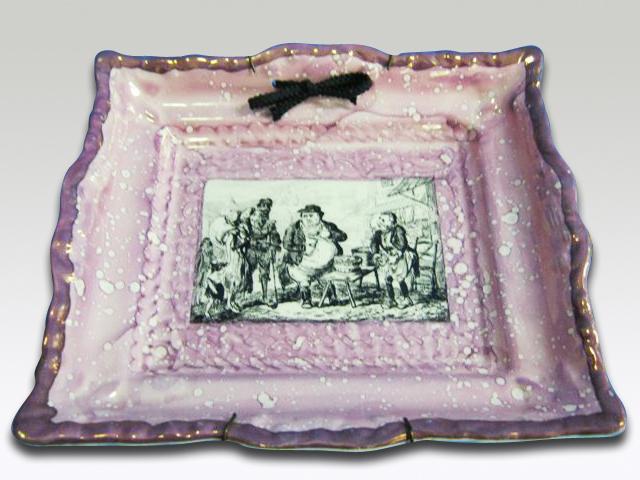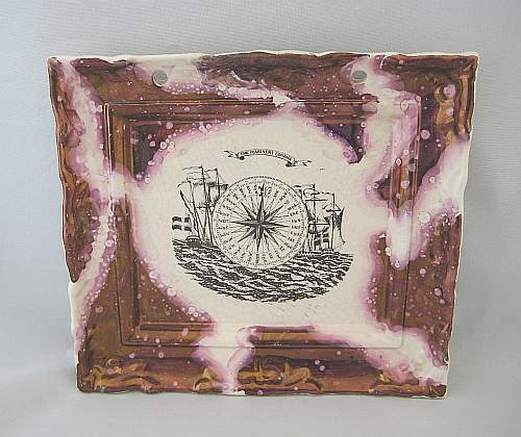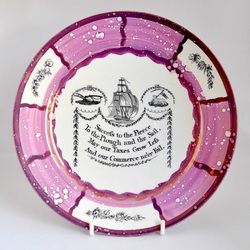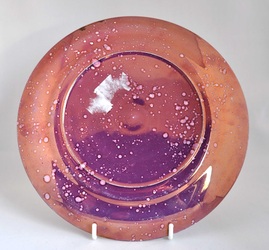|
12/1/2011 1 Comment Reproduction plaquesSince my November 24 post, about the crackle on plaques with scrolled borders, I've had an e-mail from Ian Sharp. He confirms what I've long suspected, i.e. that some of the plaques (and other items) in Michael Gibson's book on Lustreware, are in fact reproductions. Like the Adams plaque, they have scrolled borders (see Gibson plate 95, p 104, and plate 99, p 108). Paradoxically, these reproduction plaques are so rare that I've never seen one. They have, therefore, some collecting value. I found the image below on the defunct 'Antiques Republic' website, and believe the plaque is also a reproduction. It doesn't have the scrolled borders, but has the speckled lustre similar to that used by Gray's in the 1930s. Also there is a pitted inner lustre border, which I've never seen on 19th century plaques. Again, this plaque, which appears to be a scene from The Pickwick Papers, is rare enough for me to have never seen another. I've pasted a more typical 1930's reproduction below. This has the more commonly reproduced Mariners' Compass transfer. It is much less likely to be confused with genuine 19th century plaques, and has very little commercial value. Finally, I've included a picture of a bowl. Like the 'Mariner's Compass' transfer on the plaque above, 'Success to the Fleece' appears on genuine 19th century items. From the front it is hard to be sure of its age. But look at its mottled lustre back in the right photo. This only appears on 20th century items. Michael Gibson's book is illustrated with photos of the Tolsen Collection of Sunderland Lustre, which came up for sale at Sotheby's in 1998. One of the plaques in question is described in the auction catalogue (lot 407) as 'a rectangular plaque, possibly Staffordshire, late 19th century, printed with satirical courtroom scene within a moulded frame edged in purple lustre'. This is at least two steps closer to the truth. Gibson's description of the plaque as 'Sunderland' and 'c1820-1830', is completely wrong. His book has value for its many colour photographs, but shouldn't be relied upon as a reference work. Baker's 'Sunderland Pottery' remains the work of scholarship on the subject.
1 Comment
Charlene Wren
8/29/2017 12:12:43 am
I have a plate that was given to me around 1980, along with some other antiques belonging to an elderly person. Would you like to see a picture of it?
Reply
Leave a Reply. |
AuthorStephen Smith lives in London, and is always happy to hear from other collectors. If you have an interesting collection of plaques, and are based in the UK, he will photograph them for you. Free advice given regarding selling and dispersal of a collection, or to those wishing to start one. Just get in touch... Archives
February 2022
AcknowledgementsThis website is indebted to collectors, dealers and enthusiasts who have shared their knowledge or photos. In particular: Ian Holmes, Stephen Duckworth, Dick Henrywood, Norman Lowe, Keith Lovell, Donald H Ryan, Harold Crowder, Jack and Joyce Cockerill, Myrna Schkolne, Elinor Penna, Ian Sharp, Shauna Gregg at the Sunderland Museum, Keith Bell, Martyn Edgell, and Liz Denton.
|



